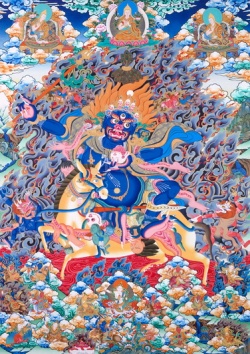Story of Palden Lhamo killing her son
Late last night I finished compiling a list of the Eight Principal Dharmapalas, or dharma protectors, of Vajrayana Buddhism. Vajrayana is most closely associated with Tibetan Buddhism, and since my practice is Japanese Zen I'm still learning about Tibetan iconography, which is richer than a New York City cheesecake.
Dharmapalas are fearsome critters, but they are not evil. They are bodhisattvas who appear in terrifying form to protect Buddhists and Buddhism. Elaborate mythologies swirl around them. Many of their stories are violent, even repugnant, and none more so than that of Palden Lhamo, the only female among the eight dharmapalas.
Palden Lhamo was married to an evil-doing king of Lanka, who habitually murdered his subjects. She tried to reform her husband, but failed. Further, their son was being raised to be the ultimate destroyer of Buddhism. One day while the king was away, she killed her son, drank his blood and ate his flesh. She rode away on a horse saddled with her son's flayed skin.
On first reading, I thought this story unnecessarily icky. But on reflection I came to appreciate the symbolism of Palden Lhamo's act. She was doing what we Buddhists are all challenged to do, which is to fully acknowledge and avow whatever harm we do. Palden Lhamo's consumption of her son was an act of atonement -- at-one-ment -- for the malevolent being who came from her own flesh.
Why the flayed skin saddle? I'm reaching a bit here, but this calls to mind a teaching that the realization of enlightenment, in a sense, rests on delusion. The great Japanese Zen teacher Eihei Dogen wrote in the Genjokoan,
Those who have great realization of delusion are buddhas; those who are greatly deluded about realization are sentient beings.
As I said, I'm reaching. If you see another interpretation, please add it to the comments.
Palden Lhamo is, among other things, the protector of the Tibetan government in exile in Lhasa, India. You can read more about her on the Tibetan Buddhist site Khandro.Net. Scroll down to read the poem about Palden Lhamo written by His Holiness the 14th Dalai Lama. Here is just a little bit of it:
All beings in the country of Tibet , although destroyed by the enemy and tormented by unbearable suffering, abide in the constant hope of glorious freedom.
How could they bear to not be given Your compassionate hand?
